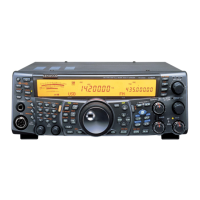Why Kenwood Transceiver no signals are received S-meter is reading full scale?
- KkhaleSep 5, 2025
If no signals are received and the S-meter is reading full scale, the RF control may be set too low. Turn the RF control fully clockwise.





Why Kenwood Transceiver no signals are received S-meter is reading full scale?
If no signals are received and the S-meter is reading full scale, the RF control may be set too low. Turn the RF control fully clockwise.
What to do if Kenwood TS-2000 attempting to transmit results in the “HELLO” message appearing?
If attempting to transmit results in the “HELLO” message appearing, first check the antenna connection and correct as necessary. Second, reduce the SWR of the antenna system. Third, correct the input voltage or use a 12 to 16V battery. Fourth, use the provided or an optional DC power cable.
Why does Kenwood Transceiver reset to factory default?
If the internal TNC resets to the factory default values after switching ON the Kenwood Transceiver, the internal TNC backup lithium battery voltage is likely too low. Have a new battery installed by your dealer or at aKKKKKEEEEENNNNNWWWWWOOOOOOOOOODDDDDService Center.
What to do if Kenwood TS-2000 Transceiver internal tuner is bypassed immediately after tuning is started?
If the internal tuner is bypassed immediately after tuning starts, the SWR of the antenna system may be too high. Adjust the antenna system to lower the SWR.
What to do if Kenwood Transceiver program scan will not start scanning?
If Program Scan will not start scanning, the start and end frequencies may be identical. Store different start and end frequencies.
What to do if Kenwood TS-2000 Transceiver memory scan will not start scanning?
If Memory Scan won't start, first, adjust the SQL control to just eliminate background noise. Second, ensure at least two memory channels are unlocked. Third, make sure data is stored in at least two memory channels.
Why Kenwood TS-2000 SSB audio quality is very poor?
Poor SSB audio quality may be due to several factors. First, check if the filter for digital operation is selected and, if so, change Menu No. 32 to OFF. Second, adjust the DSP SLOPE (LOW) control counterclockwise and the DSP SLOPE (HIGH) control clockwise. Third, ensure Noise Reduction 1 or 2 is OFF by pressing [N.R.]. Finally, verify Beat Cancel is OFF by pressing [B.C.].
Why Kenwood Transceiver frequency cannot be changed?
The Frequency Lock function may be ON. Press [F.LOCK] to switch OFF the function.
What to do if Kenwood TS-2000 no signals are received?
If no signals are received or receive sensitivity seems poor, check the following: * Ensure the SQL control is not fully clockwise; turn it counterclockwise. * Verify the Attenuator function is OFF by pressing [ATT]. * Make sure [SEND] is not pressed, which puts the transceiver in transmit mode; press [SEND] to return to receive mode. * Release Mic [PTT]. * Press [ANT] to select the other antenna connector. * Press [PRE-AMP] to switch ON function.
Why Kenwood TS-2000 does not respond correctly after pressing button?
The issue could be due to several reasons. First, ensure procedures are followed precisely. Second, check if the Frequency Lock function is ON and, if so, press [F.LOCK] to switch it OFF. Third, the microprocessor and its memory may need resetting; consider a Partial Reset or a Full Reset. Lastly, the buttons on the transceiver are unavailable while operating the Tuning control, so stop operating the Tuning control, then press the appropriate buttons.
| Antenna Impedance | 50 ohms |
|---|---|
| Supply Voltage | 13.8V DC ±15% |
| Current Drain TX | 20.5A |
| Receiver Type | Triple Conversion Superheterodyne |
| Modes | SSB, CW, AM, FM, FSK |
| Type | Base Station |
| Frequency Range TX | 0.1-60 MHz (HF), 144-148 MHz (VHF), 430-450 MHz (UHF) |
| Image Rejection | More than 70 dB |
| Selectivity | 2.4 kHz (SSB), 500 Hz (CW), 15 kHz (FM) |
| Antenna Connector | SO-239 |
| Frequency Range | HF/6m/2m/70cm |
General overview of the TS-2000/X transceiver operation with IF/AF DSP.
Details frequency conversion methods for transmission and reception modes, illustrated by Fig. 1.
Describes the local oscillator LO1 circuit for HF and 50MHz bands, including frequency generation.
Explains the local oscillator circuit for the 1.2GHz band, including its frequency configuration.
Details the pin functions and specifications of the main CPU (IC8).
Explains the pin functions and block diagram of the 16-bit CODEC (IC522,523).
Lists the parts for the HF/VHF final amplifier unit (X45-360X-XX).
Lists the parts for the filter unit (X51-315X-XX).
Shows the component and foil sides of the filter unit PCB.
Displays the component and foil sides of the UHF final unit PCB.
Describes the necessary preparations and initial settings for adjustment procedures.
Outlines the steps for entering and operating the adjustment mode.
Details the steps for uploading adjustment firmware to the unit.
Covers the adjustment procedures for various PLL circuits, including VHF MAIN PLL and SUB PLL.
Details the functions of the terminals on the final unit (X45-360 A/2).
Explains the terminal functions for the control unit (X53-391).
